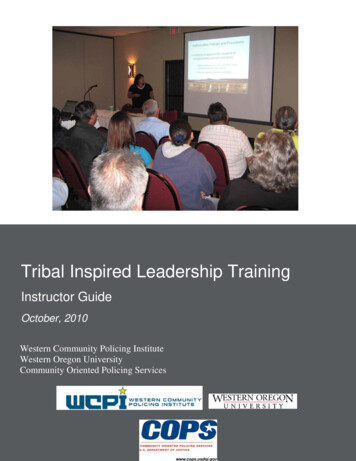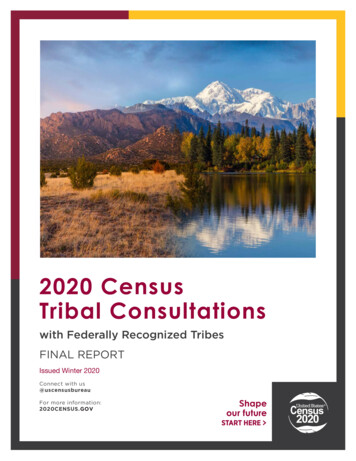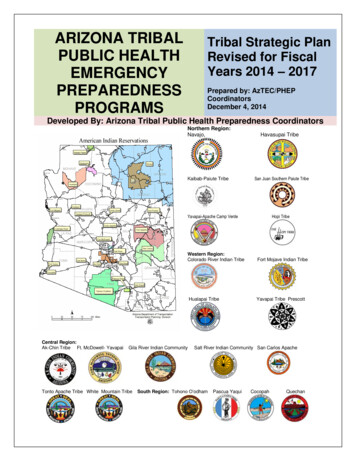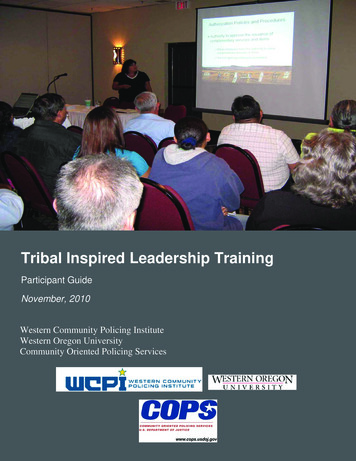
Transcription
Tribal Inspired Leadership TrainingInstructor GuideOctober, 2010Western Community Policing InstituteWestern Oregon UniversityCommunity Oriented Policing Services
Tribal Inspired Leadership TrainingInstructor GuideTable of ContentsInstructional Preparation . 1Instructor Preparation. 1Prerequisites . 4Introduction to the Instructor Guide . 4Instructor Guide-Instructional Key . 6Submitting Forms. 8MODULE 1: Introductions . 9Background: Course Provider, WCPI . 9Participant Introductions . 10Course Overview . 11Course Goal, Modules, and Objectives . 12Introduction to Technology . 14Introduction to Qwizdom . 15System Overview. 15Three Leadership Profiles . 20Leadership Decision Matrix . 21Community Policing: Looking to Tomorrow . 27Test Your Knowledge Exercise . 29TILT in Review . 30Module 1 Wrap-Up . 31Module 2: Carrying Out Community Policing Principles: Defining andUnderstanding Leadership and Management Roles . 32Help Wanted Ad Exercise Part 1 . 34Leadership and Core Cultural Competencies . 36Understanding Culture . 37Historical Events . 45The Evolution of Leadership Theory and Practice . 50Peter Drucker: Concepts of Leadership . 52Evolution of the Knowledge Worker . 54The New Dynamics of the Tribal “Knowledge Worker” . 56The Distinction between Leadership and Management . 59Leadership and Management Redefined. 63The Four Dimensions of the Leadership Test . 63Help Wanted Ad Exercise Part 2 . 66Wrap-Up . 67Page i
Tribal Inspired Leadership TrainingInstructor GuideMODULE 3: Leadership of Teams at Critical Times: The Relationship of TeamDevelopment and the Leader’s Role. 70LaJolla Indian Disaster Case Study . 73Situational Leadership Principles . 85Leadership Matrix Exercise/Group Response . 89Wrap-Up . 98Module 4: Tribal Inspired Leadership Skills: Primal Leadership and EmotionalIntelligence (EI) . 99Primal Leadership Challenge . 102The Physiological Capacity for Leadership: The Limbic System . 114Overview of the Limbic System . 115Influence, Communication, and Emotional Intelligence: The Essence of PrimalLeadership . 116Communication Analysis and Limbic Influence Exercise . 118Primal Leadership and Emotional Intelligence . 125The Essence of Primal Leadership . 127The Primal Leadership and Tribal Inspired Leadership Skills . 132Practicing Primal Leadership . 132Wrap-up. 138Module 5: Comprehensive Application of Homeland Security Strategies: TheTransformational Leader . 141Overview . 141The “Bell Waterline” Challenge . 143Elements of Transformational Leadership: Four Basic Steps for a. 152Transformational Leadership and the Moral Cause . 157Transformational Leadership Characteristics and Vision . 161The Pygmalion Effect and Transformational Leadership . 166Applying Transformational Leadership to your Leadership Challenge . 172Wrap-Up . 178Appendix180Page ii
Tribal Inspired Leadership TrainingInstructor GuideInstructional PreparationInstructor PreparationInstructors are required to read, review, and become familiar all course materials and coursedelivery guidelines, focusing on how these materials support the course goal and objectives.Also, to meet the unique needs of each community, instructors should be prepared to providethe following information. Training venue information, including available water fountains, bathrooms, localrestaurants, and emergency contact informationCurrent or recent events in the community that may enhance the relevance ofcommunity policing trainingCurrent ―hot button‖ (highly controversial or politically charged) issues in the communitythat may need to be addressed with caution or placed in a ―parking lot‖ (agreement todiscuss at a later date) statusClassroom TechnologyEach classroom should contain the following multi-media technology. This technology shouldbe set up and tested prior to the delivery of this course to ensure that technology isvisible/audible to all participants. (NOTE: The instructor may have to bring this technologyif it is not available.) Windows-based computerLCD (media) projector and screenSound systemChart pack paper, easel, and bold markersClassroom PreparationAll supplies, such as chart-pack paper and markers, participant manuals (which includes pretests, post-test, and ―Action Planning‖ forms), course textbooks, sign-in registrations, courseevaluation forms, and pens and pencils, should be available and set up prior to the start of thecourse.The classroom should be arranged to promote interaction and adult learning principles. Thisincludes the use of "rounds" that accommodate six participants per table. If this arrangement isnot possible then a fan-shape set up is appropriate (see figure 1).October, 2010Version 1Page 1
Tribal Inspired Leadership TrainingInstructor GuideFigure 1Table(Front)"Fan Shape""Rounds"Instructor TeamsThis course is intended to be delivered following a 1 instructor to 20 student ratio. Instructorassignments for each module should be determined well in advance of the training. Thoseinstructors who are not actively delivering a module are to be assigned to one or moreparticipant teams to support team activities. Therefore, it is essential that instructors are familiarwith the entire course content, including activities, video clips, reference materials, and timeguidelines. This course is time sensitive, and it is the responsibility of the instructor to maintainthe time guidelines for each module.Evaluation StrategyThe evaluation strategy designed for this course contains three major elements: a test yourknowledge pre- and post-test, participant evaluation response, and instructor observation. Toevaluate participants‘ level of learning, test your knowledge exercises (pre-test) will beadministered at the beginning of Modules 2, 3, 4, and 5. At the conclusion of each of thesemodules a test your knowledge exercise (post-test) will be given. Through comparison of thepre- and post-test results, participants‘ level of learning will be determined. Also, throughout thetraining, each participant or group will use the Qwizdom technology providing individualresponses and participation in group discussions related to the challenge scenarios.Participant GuideA Participant Guide is provided which contains the following: Course contentTest Your Knowledge Exercises (pre-and post-tests)Reference materialsOctober, 2010Version 1Page 2
Tribal Inspired Leadership TrainingInstructor GuideCourse TextbooksParticipant teams will be given the Tribal Inspired Leadership Training Participant‟s Guide as aworkbook for the course.Course DevelopmentThis course was developed by the Western Community Policing Institute (WCPI) to support theCommunity Oriented Policing Services (COPS) Office. The COPS Office redefines communitypolicing as ―a philosophy that promotes organizational strategies, which support the systematicuse of partnerships and problem solving techniques, to proactively address the immediateconditions that give rise to public safety issues, such as crime, social disorder, and fear ofcrime.” (United States Department of Justice, Office of Community Oriented Policing Services,March 2008)This course offers ―hands-on‖ application and insight into an executive/leader‘s role andresponsibilities in implementing and managing community policing. This course is designed asa stand-alone curriculum that can be delivered ―off-the-shelf.‖ The course content is designed tobe relevant to any community policing.Cognitive Course GoalThis course is designed to train and equip executives with the skills necessary to makeleadership decisions for the purpose of preparing and implementing community policing.Note: The information presented and the terminologies used in this course were correct at thetime this course was developed.Participant ProfileThe target audience for this program are leaders representing a broad spectrum of Tribaljurisdictions that have official responsibility in implementing and/or advancing communitypolicing in the following disciplines: Law enforcementEmergency medical servicesFire servicesHazardous materialsPublic worksGovernment administrationPublic safety communicationsMedical/health careEducationEmergency managersCommunity StakeholdersOctober, 2010Version 1Page 3
Tribal Inspired Leadership TrainingInstructor GuideAny other executives who have direct oversight or involvement in community policing will alsobe included. Special attention will be placed on training those leaders with limited access,including time and financial constraints, to community policing training.Target Audience NeedsMembers of the target audience are at the forefront of implementing and/or advancingcommunity policing. The ability of executives to provide leadership in implementing and/oradvancing community policing are critical components in involving the community in theorganizations application of community policing principles. Creating these abilities allows Tribalcommunities to implement and/or advance community policing that will improve the quality of lifein the community. This course will provide participants with working information in the followingareas: A knowledge of leadership and management theories and skills and their relationshipto community policingA knowledge of the organization and goals of the COPS OfficeIdentifying needed leadership skills through case studiesPrerequisitesGeneral PrerequisitesAll course participants must be recognized as leaders in their respective communities activelyinvolved in decision-making, leadership, or responsibility of community policing activities.Prerequisite Knowledge, Skills, and AbilitiesIn order to attend the Tribal Inspired Leadership Training (TILT) course, participants listed in theParticipant Profile section should have the criteria defined in the area of Target Audience Needs(refer back to the Participant Profile section).Introduction to the Instructor GuideStructure and Purpose of this GuideThis Instructor Guide is for delivering the sixteen-hour Tribal Inspired Leadership Training(TILT) and supports the COPS Office.The general purpose and structure of this guide is designed to provide the instructors with: Facilitation guidelines for the delivery of the content in a detailed, but flexible formatDetailed facilitation guidance of course activities and video clipsOctober, 2010Version 1Page 4
Tribal Inspired Leadership TrainingInstructor Guide Adult learning concepts and strategiesBlended learning strategiesThe course will provide participants with: An understanding of leadership theories and skills as they relate to communitypolicingAn understanding of the philosophy of leadership as a useful tool for all public safetyexecutives to address community policing issuesAn understanding of the definition, components, and goals of the COPS OfficeAn understanding and evaluation of case studiesPurposeThe purpose of this executive-level national training program is to train and support Triballeaders from all communities. These leaders with decision-making authority and responsibilitieswill gain direct/indirect, formal/informal training in existing and emerging community policingprinciples, policies, and procedures.The general purpose and structure of this guide is designed to provide: Facilitation guidelines for the delivery of the content in a detailed, but flexible format Blended Learning Strategies Detailed facilitation guidance of course activities and video clipsOctober, 2010Version 1Page 5
Tribal Inspired Leadership TrainingInstructor GuideInstructor Guide-Instructional KeyIconDescriptionKnowledge Check: Used when it is time toassess the learners‘ understandingExample: Used when there is a descriptiveillustration to show or explainKey Points: Used to convey essential learningconcepts, discussions and introduction ofsupplemental materialChallenge coin: Used during the curriculumdelivery when special emphasis or attention tocommunity oriented policing is notedMentor: The mentor serves as the virtualhistorical ―bridge‖ to assist participants withusing the available tools and resources duringthe trainingTransformationalServant to his/her peopleSuccess of purpose drivenGives creditArticulateWolfIntelligentAmbitiousStrong egoSpiritualWhitePeopleEldersNORTH: oplePhysicalReceive EnergyEmotionalCenteredBirthMental AspectWEST: BlackHolds EnergySpringDetermine EnergyMESunIllumination t & InnocencenaMentalTeenagerslRed manAdaptiveBuffaloDirectiveSelf AwarenessWarmthLightWaterPlantsGives EnergyEmotional AspectRedFlexibleSelf ManagementYellowSOUTH: RedAutumnSeedsSpiritual AspectInsightFallOrientalSun/FireCREATORPhysical AspectIntrospection &EAST: veWisdom & adership Decision Matrix: The LeadershipDecision Matrix activities or interactive scenariobased challenges are designed to developleader‘s skills, by prompting leaders in thedecision-making processesHint: Used to cover administrative items orinstructional tips that aid in the flow of theinstructionQuestion to Class: Used when instructor is toquestion the class, possible responses areincluded in yellow highlighted textInstructor Guide - Color Coding KeyThis Instructor Guide has been color-coded for specific purposes. All pages and texts with colorshading indicate information that is included for instructor assistance, and this information is notprovided in the participant workbook. The yellow-shaded text indicates supplemental orsupporting information and facilitation instructions added for instructor clarification. The goldshading indicates a Qwizdom activity. All other non-shaded text is included in the participantworkbook.October, 2010Version 1Page 6
Tribal Inspired Leadership TrainingInstructor GuideUsing PowerPointA supporting PowerPoint presentation is provided for this course. This presentation should beused as a visual aid to support course content, and it is not intended to replace any of therequired information to be delivered orally by the instructor.Facilitating ActivitiesActivities are included in this course, both to support learning and to build and foster groupdiscussion. To ensure that participants get the most out of these activities, instructions forfacilitating and debriefing activities are included in the Instructor Guide contained in the―Instructional Notes and Instructional Directions‖.Presenting VideosVideo clips have been included in this course to illustrate specific concepts and ideas. Videoset-up and debrief is essential to help participants relate the information contained in the videoclip to what is being learned in this course. Video summaries explaining video set-up anddebrief are included in the Instructor Guide ―Instructional Notes‖.Application to Tribal Inspired LeadershipIn addition to the Instructional Directions and Instructional Notes, participants will be presenteda Application to Tribal Inspired Leadership. The purpose of the Application to Tribal InspiredLeadership section is to relate the content of the curriculum in the module to participant‘scommunity policing leadership and decision-making responsibilities.Simulator and Mentor ActivitiesThe historical leadership profiles of selected ―mentors‖ are available throughout the presentedscenario based challenges to provide leaders with help, advice, and commentary as they maketheir way through the simulation. The mentor serves as the virtual historical ―bridge‖ that assistsparticipants with using the available tools and resources during the training. These scenariobased challenges are designed to develop a leader‘s skills, by prompting leaders in thedecision-making processes relating to community policing.The leadership challenges are not static, as new issues and complications emerge over time some are direct responses to actions taken (or not taken) by leaders. The flexible decisionmaking design of the challenge scenario tool allows for continuous and enhanced learning totake place at all levels of experience. The scenarios are designed to provide a guidedexperience into the use of skills, tools, resources, and new thought processes.October, 2010Version 1Page 7
Tribal Inspired Leadership TrainingInstructor GuideSubmitting FormsInstructors are to ensure that the following forms are available, properly completed,collected, and submitted to WCPI at the close of this course. Registration Forms*Student Assessment of Course*Registration forms must be completely filled out Lead instructor is responsible for ensuring that all fields on the registration form arecompleteo Fields in bold* are required and must be completed Last Name First Name City State Zip Code Work Phone Level of Government Student Discipline Registration forms will not be accepted if they are incomplete.All information provided by participants during this training, including COPS registrationforms, state POST attendance rosters and/or any other attendance rosters are for thesole use of WCPI and POST reporting purposes. The information gathered at thistraining is not to be copied, duplicated, stored or transmitted by any means withoutexpressed or written consent by Western Community Policing Institute.October, 2010Version 1Page 8
Tribal Inspired Leadership TrainingInstructor GuideMODULE 1: IntroductionsTribal Inspired Leadership TrainingOctober, 20100Instructional Directions: Show PPT slide 0. This is the cover slide for the course. Circulatesign-in roster forms, asking participants to provide the most complete and accurate informationpossible. Each participant will submit the appropriate forms required for information gathering.Note: This is a requirement of the training. Show PPT slides 1 and 2. Welcome participants,introduce yourself and the training staff-allowing the training staff time to introduce themselves,and provide a brief overview of your training organization. For example: Western CommunityPolicing Institute (WCPI). Refer participants to the applicable page number in their ParticipantGuide for this module.TILT Course Providers Sponsored by U.S. Department of Justice/CommunityOriented Policing Services– Award #2009 HEWXK002 Developed by Western Oregon University/WesternCommunity Policing Institute11Background: Course Provider, WCPIThis project was supported by Cooperative Agreement Number 2009HEWXK001 awarded bythe Office of Community Oriented Policing Services, U.S. Department of Justice. The opinionscontained herein are those of the author(s) and do not necessarily represent the official positionor policies of the U.S. Department of Justice. References to specific agencies, companies,products, or services should not be considered an endorsement by the author(s) or the U.S.Department of Justice. Rather, the references are illustrations to supplement discussion of theissues.The grant award number is:2009HEWXK002The author of this curriculum is the Western Community Policing Institute (WCPI).October, 2010Version 1Page 9
Tribal Inspired Leadership TrainingInstructor GuideWestern Community PolicingInstitute Funded by the U.S. Department ofJustice/COPS Delivering training since 1996 Located at Western Oregon University inMonmouth, OR22Some background facts about WCPI are as follows: Funded by the U.S. Department of Justice, (COPS) and the U.S. Department ofHomeland Security (FEMA), Responder Training.govLocated at Western Oregon University in Monmouth, OregonDelivering training since 1996Course Logistics Coffee Restrooms Phone calls andpagers Breaks and meals Seating arrangement Sign-in roster Participant notebooks33Instructional Directions: Show PPT slide 3. Provide housekeeping details for the course,including necessary forms, breaks, and cell phone usage.Module I: Introductions44Participant IntroductionsInstructional Directions: Show PPT slide 4. At this point, allow participants the opportunityto introduce themselves. For introductions have participants spend a few minutes introducingthemselves at their tables. To set up introductions tell participants that they have a few minutesto introduce themselves giving their names and the organization that they work for. Tell themthat this is the only work related information that they can share. Have them spend the next fewminutes talking about anything other than work related items. After a few minutes askOctober, 2010Version 1Page 10
Tribal Inspired Leadership TrainingInstructor Guideparticipants what they talked about. Flip chart responses which will include things such asfamily, vacation, sports retirement, pets, etc. Ask participants if these are the most importantthings to them and their employees. Explain that one important aspect of leadership takes intoconsideration what is most important to others. When developing personal relationships leadersneed to know what is important to their employees.What is important to youremployees?“Undercover Boss”Course Overview Interactive Scenario-based Training uses historical examples to examineleadership ―Last chapters of their lives havebeen written. We can look at their actions basedon historical events.” Designed for public safety and Tribal leaders Requires active participation and problemsolvingLeadershipis .Leadership Influencingpromotes . Motivating Inspiring Being Credible Caring CompassionateHow well do you know your employees .55677Course OverviewInstructional Directions: Show PPT slides 5, 6, and 7. These slides provide somebackground information on the course itself and the goals of this course. Give a brief overviewof the course goals and learning objectives; explain that these objectives will be covered ingreater detail throughout the course. These slides identify certain key points of interest theparticipants should be on the lookout for as they work through the course materials (i.e.,enabling objectives, Qwizdom activities, and discussion questions).This course is comprised of five modules. The course is challenge and scenario-based,requiring active participation and problem-solving. Participants will evaluate case studies andshared experiences in the context of an executive‘s leadership approach in implementing andadministering community policing within the Tribal community. In each module, participantsexamine and discuss the need for leadership and the importance of community policing. Theconcluding module provides final summary thoughts regarding identified issues and provides awrap-up for this course.Course GoalThis course is designed totrain and equip Tribalexecutives with the skillsnecessary to make leadershipdecisions for the purpose ofpreparing and implementingcommunity policing strategies.88Instructional Directions: Show PPT slide 8. This slide provides a description of the goal ofthis course.October, 2010Version 1Page 11
Tribal Inspired Leadership TrainingInstructor GuideCourse Goal, Modules, and ObjectivesCourse GoalThis course is designed to train and equip executives with the skills necessary to makeleadership decisions for the purpose of implementing and administering public safety programswith a community policing philosophy in their community.Course ModulesThe other modules in this course include: Carrying Out Community Policing Principles: Defining and Understanding Leadershipand Management Roles.Successfully Integrating and Synchronizing Community Policing Principles throughLeadership: Situational Leadership.Community Policing Executive Leadership Skills: The Primal Leaders and EmotionalQuotient (EQ).Comprehensive Application of Community Policing Principles: The TransformationalLeader.Instructional Notes: At the beginning of each module participants will be presented with themodule‘s learning objective. A learning objective corresponds to the overall instructional goalsof the course. Each module‘s learning objective describes what participants will be able to do atthe end of the module.To assist participants in successfully completing this course, each module identifies enablingobjectives that are presented throughout the training. At the beginning of each module theenabling objectives are listed and reviewed. These enabling objectives are mechanisms toassist participants in achieving the learning objective for each module.Learning ObjectivesA learning objective corresponds tothe overall instructional goals of thecourse. Each module’s learningobjective describes whatparticipants will be able to do at theend of the module.99Learning Objectives Show PPT slide 9.A learning objective corresponds to the overall instructional goals of the course. Each module‘slearning objective describes what participants will be able to do at the end of the module.October, 2010Version 1Page 12
Tribal Inspired Leadership TrainingInstructor GuideModule I – LearningObjectiveTo introduce participants to theframework of the Tribal InspiredLeadership Training course1010Module 1: Learning Objective (LO) Show PPT slide 10.To introduce participants to the framework of the Tribal Inspired Leadership Training course.Enabling ObjectivesAt the beginning and conclusion of eachmodule, participants will be presented theCourse‘s Enabling Objectives. TheEnabling Objectives are presented forparticipants to achieve the TerminalLearning Objectives.1111Enabling Objectives Show PPT slide 11.At the beginning and conclusion of each module, participants will be presented the Course‘sEnabling Objectives. Th
Tribal Inspired Leadership Training Instructor Guide October, 2010 Version 1 Page 3 Course Textbooks Participant teams will be given the Tribal Inspired Leadership Training Participant‟s Guide as a workbook for the course. Course Development This course was developed by the Western Community Policing Institute (WCPI) to support the










